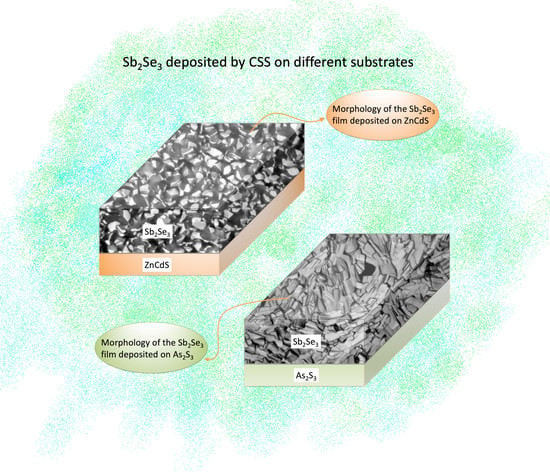Sb2Se3 Polycrystalline Thin Films Grown on Different Window Layers
Abstract
1. Introduction
2. Materials & Methods
- 1.
- n-type part (all these films are MS deposited)
- a.
- Transparent Conducting Oxide (TCO) made up of an 800 nm thick ITO film
- b.
- high resistivity transparent (HRT) ZnO layer, 150 nm thick
- c.
- CdS, CdS:F, CdS + CdSe, CdS + , CdS + ZnCdS films representing the different window layers used for testing, whose thicknesses are described in Table 1.
- 2.
- p-type part
- a.
- Absorber layer– film, thick (CSS-deposited)
- b.
- Back contact– film, 200 nm thick covered by Pt film, 100 nm thick (both films are MS deposited)
3. Results and Discussion
3.1. Structural Characterization
3.2. Electrical Characterization
- is the sample thickness
- is the resistivity
- is the average resistance over the possible pairs combinations of contacts and . The same is true for .
4. Conclusions
Author Contributions
Funding
Institutional Review Board Statement
Informed Consent Statement
Data Availability Statement
Acknowledgments
Conflicts of Interest
References
- Chen, C.; Li, K.; Tang, J. Ten years of Sb2Se3 thin film solar cells. Solar RRL 2022, 6, 2200094. [Google Scholar] [CrossRef]
- Chen, C.; Li, W.; Zhou, Y.; Chen, C.; Luo, M.; Liu, X.; Zeng, K.; Yang, B.; Zhang, C.; Han, J.; et al. Optical properties of amorphous and polycrystalline Sb2Se3 thin films prepared by thermal evaporation. Appl. Phys. Lett. 2015, 107, 043905. [Google Scholar] [CrossRef]
- Lin, L.Y.; Jiang, L.Q.; Qiu, Y.; Fan, B.D. Analysis of Sb2Se3/CdS based photovoltaic cell: A numerical simulation approach. J. Phys. Chem. Solids 2018, 122, 19–24. [Google Scholar] [CrossRef]
- Madelung, O. Semiconductors: Data Handbook; Springer: Berlin/Heidelberg, Germany, 2004. [Google Scholar]
- Zhou, Y.; Leng, M.; Xia, Z.; Zhong, J.; Song, H.; Liu, X.; Yang, B.; Zhang, J.; Chen, J.; Zhou, K.; et al. Solution-processed antimony selenide heterojunction solar cells. Adv. Energy Mater. 2014, 4, 1301846. [Google Scholar] [CrossRef]
- Mavlonov, A.; Razykov, T.; Raziq, F.; Gan, J.; Chantana, J.; Kawano, Y.; Nishimura, T.; Wei, H.; Zakutayev, A.; Minemoto, T.; et al. A review of Sb2Se3 photovoltaic absorber materials and thin-film solar cells. Solar Energy 2020, 201, 227–246. [Google Scholar] [CrossRef]
- Shockley, W.; Queisser, H.J. Detailed balance limit of efficiency of P-n junction solar cells. J. Appl. Phys. 1961, 32, 510. [Google Scholar] [CrossRef]
- Mamta; Singh, Y.; Maurya, K.K.; Singh, V.N. A review on properties, applications, and deposition techniques of antimony selenide. Sol. Energy Mater. Sol. Cells 2021, 230, 111223. [Google Scholar] [CrossRef]
- Wang, L.; Li, D.B.; Li, K.; Chen, C.; Deng, H.X.; Gao, L.; Zhao, Y.; Jiang, F.; Li, L.; Huang, F.; et al. Stable 6%-efficient Sb2Se3 solar cells with a ZnO buffer layer. Nat. Energy 2017, 2, 17046. [Google Scholar] [CrossRef]
- Phillips, L.J.; Savory, C.N.; Hutter, O.S.; Yates, P.J.; Shiel, H.; Mariotti, S.; Bowen, L.; Birkett, M.; Durose, K.; Scanlon, D.O.; et al. Current enhancement via a TiO2 window layer for CSS Sb2Se3 solar cells: Performance limits and high VOC is with the G. IEEE J. Photovolt. 2019, 9, 544–551. [Google Scholar] [CrossRef]
- Wen, X.; Chen, C.; Lu, S.; Li, K.; Kondrotas, R.; Zhao, Y.; Chen, W.; Gao, L.; Wang, C.; Zhang, J.; et al. Vapor transport deposition of antimony selenide thin film solar cells with 7.6% efficiency. Nat. Commun. 2018, 9, 2179. [Google Scholar] [CrossRef]
- Li, Z.; Liang, X.; Li, G.; Liu, H.; Zhang, H.; Guo, J.; Chen, J.; Shen, K.; San, X.; Yu, W.; et al. 9.2%-efficient core-shell structured antimonyselenide nanorod array solar cells. Nat. Commun. 2019, 10, 125. [Google Scholar] [CrossRef]
- Zhou, Y.; Wang, L.; Chen, S.; Qin, S.; Liu, X.; Chen, J.; Xue, D.-J.; Luo, M.; Cao, Y.; Cheng, Y.; et al. Thin-film Sb2Se3 photovoltaics with oriented one-dimensional ribbons and benign grain boundaries. Nat. Photonics 2015, 9, 409–415. [Google Scholar] [CrossRef]
- Wang, Y.; Ji, S.; Shin, B. Interface engineering of antimony selenide solar cells: A review on the optimization of energy band alignments. J. Phys. Energy 2022, 4, 044002. [Google Scholar] [CrossRef]
- Oliveira, A.J.N.; Teixeira, J.P.; Ramos, D.; Fernandes, P.A.; Salomé, P.M.P. Exploiting the optical limits of thin-film solar cells: A review on light management strategies in Cu(In,Ga)Se2. Adv. Photonics Res. 2022, 3, 2100190. [Google Scholar] [CrossRef]
- Bosio, A.; Pasini, S.; Romeo, N. The history of photovoltaics with emphasis on CdTe solar cells and modules. Coatings 2020, 10, 344. [Google Scholar] [CrossRef]
- Mamta; Maurya, K.K.; Singh, V.N. Enhancing the performance of an Sb2Se3-based solar cell by dual buffer layer. Sustainability 2021, 13, 2320. [Google Scholar] [CrossRef]
- Romeo, N.; Bosio, A.; Menossi, D.; Catellani, C.; Dharmadasa, R.; Romeo, A. High efficiency Cu(In,Ga)Se2/CdS thin film solar cells obtained with precursors sputtered from InSe, GaSe and Cu targets. Thin Solid Films 2013, 535, 88–91. [Google Scholar] [CrossRef]
- Liu, X.; Xiao, X.; Yang, Y.; Xue, D.-J.; Li, D.-B.; Chen, C.; Lu, S.; Gao, L.; He, Y.; Beard, M.C.; et al. Enhanced Sb2Se3 solar cell performance through theory-guided defect control. Res. Appl. 2017, 25, 861–870. [Google Scholar] [CrossRef]
- Wijesinghe, U.; Longo, G.; Hutter, O.S. Defect engineering in antimony selenide thin film solar cells. Energy Adv. 2023, 2, 12–33. [Google Scholar] [CrossRef]
- Romeo, N.; Cozzi, S.; Tedeschi, R.; Bosio, A.; Canevari, V.; Tagliente, M.A.; Penza, M. High quality ZnS:Mn thin films grown by quasi-rheotaxy for electroluminescent devices. Thin Solid Films 1999, 348, 49–55. [Google Scholar] [CrossRef]
- Romeo, N. Quasi-rheotaxy: Growth of large crystalline Grain thin films on quasi-liquid substrates. J. Cryst. Growth 1981, 52, 692–698. [Google Scholar] [CrossRef]
- Romeo, N. Quasi-rheotaxial growth of large crystalline grain thin films on low cost substrates for photovoltaic applications. Prog. Cryst. Growth Charact. 1984, 9, 169–183. [Google Scholar] [CrossRef]
- Romeo, N.; Canevari, V.; Sberveglieri, G.; Tosi, A.; Camanzi, A. Quasi-rheotaxy a new technique to grow large grain thin films on low cost amorphous substrates. Rev. Phys. Appliquée 1981, 16, 11–14. [Google Scholar] [CrossRef]
- Borisova, Z.U. Glassy Semiconductors; Springer: Berlin/Heidelberg, Germany, 1981. [Google Scholar]
- Li, G.; Li, Z.; Liang, X.; Guo, C.; Shen, K.; Mai, Y. Improvement in Sb2Se3 solar cell efficiency through band alignment engineering at the buffer/absorber interface. ACS Appl. Mater. Interfaces 2019, 11, 828–834. [Google Scholar] [CrossRef]
- Xiao, P.; Huang, J.; Yan, D.; Luo, D.; Yuan, J.; Liu, B.; Liang, D. Emergence of nanoplatelet light-emitting diodes. Materials 2018, 11, 1376. [Google Scholar] [CrossRef]
- Chen, G.; Ning, Z.; Ågren, H. Nanostructured solar cells. Nanomaterials 2016, 6, 145. [Google Scholar] [CrossRef] [PubMed]
- Frontiers of Nanoscience; Ritchie, D.A., Ed.; Elsevier: Amsterdam, The Netherlands, 2021; Volume 20, ISBN 1876-2778. [Google Scholar]
- Romeo, N.; Fermi, F.; Tedeschi, R.; Bosio, A.; Canevari, V.; Cozzi, S. Large grain electroluminescent ZnS:Mn thin films grown by quasi-rheotaxy on insulating materials. Thin Solid Films 2001, 384, 138–145. [Google Scholar] [CrossRef]
- Chopade, P.; Jagtap, S.; Gosavi, S. Material properties and potential applications of CdSe semiconductor nanocrystals. In Nanoscale Compound Semiconductors and Their Optoelectronics Applications; Elsevier: Amsterdam, The Netherlands, 2022; pp. 105–153. ISBN 9780128240632. [Google Scholar]
- Khan, Z.H. (Ed.) Emerging Trends in Nanotechnology; Springer: Berlin/Heidelberg, Germany, 2021. [Google Scholar]
- Lee, J.; Mathai, M.; Jain, F.; Papadimitrakopoulos, F. Layer-by-layer growth of CdSe-based nanocrystal light-emitting diodes. J. Nanosci. Nanotechnol. 2001, 1, 59–64. [Google Scholar] [CrossRef]
- Pattini, F.; Rampino, S.; Mezzadri, F.; Calestani, D.; Spaggiari, G.; Sidoli, M.; Delmonte, D.; Sala, A.; Gilioli, E.; Mazzer, M. Role of the substrates in the ribbon orientation of Sb2Se3 films grown by low-temperature pulsed electron deposition. Sol. Energy Mater. Sol. Cells 2020, 218, 110724. [Google Scholar] [CrossRef]
- Moon, B.S.; Lee, J.H.; Jung, H. Comparative studies of the properties of CdS films deposited on different substrates by R.F. Sputtering. Thin Solid Films 2006, 511–512, 299–303. [Google Scholar] [CrossRef]
- Romeo, N.; Bosio, A.; Canevari, V. The role of CdS preparation method in the performance of CdTe/CdS thin film solar cell. In Proceedings of the 3rd World Conference on Photovoltaic Energy Conversion, Osaka, Japan, 11–18 May 2003; pp. 469–470. [Google Scholar]
- Ninomiya, S.; Adachi, S. Optical properties of cubic and hexagonal CdSe. J. Appl. Phys. 1995, 78, 4681–4689. [Google Scholar] [CrossRef]
- Tan, W.C.; Solmaz, M.E.; Gardner, J.; Atkins, R.; Madsen, C. Optical characterization of A-As2S3 thin films prepared by magnetron sputtering. J. Appl. Phys. 2010, 107, 033524. [Google Scholar] [CrossRef]
- Kumar, S.; Rajpal, S.; Sharma, S.K.; Kumar, S.R. Influence of annealing on ZnCdS thin films: Structural and optical properties. AIP Conf. Proc. 2021, 1, 040015. [Google Scholar]
- Guo, L.; Zhang, B.; Li, S.; Montgomery, A.; Li, L.; Xing, G.; Zhang, Q.; Qian, X.; Yan, F. Interfacial engineering of oxygenated chemical bath–deposited CdS window layer for highly efficient Sb2Se3 thin-film solar cells. Mater. Today Phys. 2019, 10, 100125. [Google Scholar] [CrossRef]
- Ge, J.; Koirala, P.; Grice, C.R.; Roland, P.J.; Yu, Y.; Tan, X.; Ellingson, R.J.; Collins, R.W.; Yan, Y. Oxygenated CdS buffer layers enabling high open-circuit voltages in earth-abundant Cu2BaSnS4 thin-film solar cells. Adv. Energy Mater. 2017, 7, 1601803. [Google Scholar] [CrossRef]
- Meysing, D.M.; Wolden, C.A.; Griffith, M.M.; Mahabaduge, H.; Pankow, J.; Reese, M.O.; Burst, J.M.; Rance, W.L.; Barnes, T.M. Properties of reactively sputtered oxygenated cadmium sulfide (CdS:O) and their impact on CdTe solar cell performance. J. Vac. Sci. Technol. A Vac. Surf. Film. 2015, 33, 021203. [Google Scholar] [CrossRef]
- Romeo, N.; Bosio, A.; Canevari, V.; Podestà, A. Recent progress on CdTe/CdS thin film solar cells. Sol. Energy 2004, 77, 795–801. [Google Scholar] [CrossRef]
- Van der Pauw, L.J. A method of measuring specific resistivity and hall effect of discs of arbitrary shape. Semicond. Devices Pioneer. Pap. 1958, 13, 174–182. [Google Scholar]
- Momma, K.; Izumi, F. VESTA3 for three-dimensional visualization of crystal, volumetric and morphology data. J. Appl. Crystallogr. 2011, 44, 1272–1276. [Google Scholar] [CrossRef]
- Krautmann, R.; Spalatu, N.; Gunder, R.; Abou-Ras, D.; Unold, T.; Schorr, S.; Krunks, M.; Oja Acik, I. Analysis of grain orientation and defects in Sb2Se3 solar cells fabricated by close-spaced sublimation. Solar Energy 2021, 225, 494–500. [Google Scholar] [CrossRef]
- Vidal-Fuentes, P.; Guc, M.; Alcobe, X.; Jawhari, T.; Placidi, M.; Pérez-Rodríguez, A.; Saucedo, E.; Roca, V.I. Multiwavelength excitation raman scattering study of Sb2Se3 compound: Fundamental vibrational properties and secondary phases detection. 2D Mater. 2019, 6, 045054. [Google Scholar] [CrossRef]
- Spaggiari, G.; Pattini, F.; Bersani, D.; Calestani, D.; de Iacovo, A.; Gilioli, E.; Mezzadri, F.; Sala, A.; Trevisi, G.; Rampino, S. Growth and structural characterization of Sb2Se3 solar cells with vertical Sb4Se6 ribbon alignment by RF magnetron sputtering. J. Phys. D Appl. Phys. 2021, 54, 385502. [Google Scholar] [CrossRef]
- Chen, C.; Bobela, D.C.; Yang, Y.; Lu, S.; Zeng, K.; Ge, C.; Yang, B.; Gao, L.; Zhao, Y.; Beard, M.C.; et al. Characterization of basic physical properties of Sb2Se3 and its relevance for photovoltaics. Front. Optoelectron. 2017, 10, 18–30. [Google Scholar] [CrossRef]
- Adinolfi, V.; Yuan, M.; Comin, R.; Thibau, E.S.; Shi, D.; Saidaminov, M.I.; Kanjanaboos, P.; Kopilovic, D.; Hoogland, S.; Lu, Z.H.; et al. The in-gap electronic state spectrum of methylammonium lead iodide single-crystal perovskites. Adv. Mater. 2016, 28, 3406–3410. [Google Scholar] [CrossRef] [PubMed]
- Le Corre, V.M.; Duijnstee, E.A.; el Tambouli, O.; Ball, J.M.; Snaith, H.J.; Lim, J.; Koster, L.J.A. Revealing charge carrier mobility and defect densities in metal halide perovskites via space-charge-limited current measurements. ACS Energy Lett. 2021, 6, 1087–1094. [Google Scholar] [CrossRef] [PubMed]
- Duijnstee, E.A.; Ball, J.M.; le Corre, V.M.; Koster, L.J.A.; Snaith, H.J.; Lim, J. Toward understanding space-charge limited current measurements on metal halide perovskites. ACS Energy Lett. 2020, 5, 376–384. [Google Scholar] [CrossRef]
- Peng, W.; Miao, X.; Adinolfi, V.; Alarousu, E.; el Tall, O.; Emwas, A.-H.; Zhao, C.; Walters, G.; Liu, J.; Ouellette, O.; et al. Engineering of CH3NH3PbI3 perovskite crystals by alloying large organic cations for enhanced thermal stability and transport properties. Angew. Chem. 2016, 128, 10844–10848. [Google Scholar] [CrossRef]
- Liang, G.X.; Luo, Y.d.; Chen, S.; Tang, R.; Zheng, Z.H.; Li, X.J.; Liu, X.S.; Liu, Y.K.; Li, Y.F.; Chen, X.Y.; et al. Sputtered and selenized Sb2Se3 thin-film solar cells with open-circuit voltage exceeding 500 MV. Nano Energy 2020, 73, 104806. [Google Scholar] [CrossRef]
- Chen, K.; Wu, P.; Yang, W.; Su, R.; Luo, D.; Yang, X.; Tu, Y.; Zhu, R.; Gong, Q. Low-dimensional perovskite interlayer for highly efficient lead-free formamidinium tin iodide perovskite solar cells. Nano Energy 2018, 49, 411–418. [Google Scholar] [CrossRef]
- Spalatu, N.; Krautmann, R.; Katerski, A.; Karber, E.; Josepson, R.; Hiie, J.; Acik, I.O.; Krunks, M. Screening and optimization of processing temperature for Sb2Se3 thin film growth protocol: Interrelation between grain structure, interface intermixing and solar cell performance. Sol. Energy Mater. Sol. Cells 2021, 225, 111045. [Google Scholar] [CrossRef]
- Rijal, S.; Li, D.B.; Awni, R.A.; Xiao, C.; Bista, S.S.; Jamarkattel, M.K.; Heben, M.J.; Jiang, C.S.; Al-Jassim, M.; Song, Z.; et al. Templated growth and passivation of vertically oriented antimony selenide thin films for high-efficiency solar cells in substrate configuration. Adv. Funct. Mater. 2022, 32, 2110032. [Google Scholar] [CrossRef]
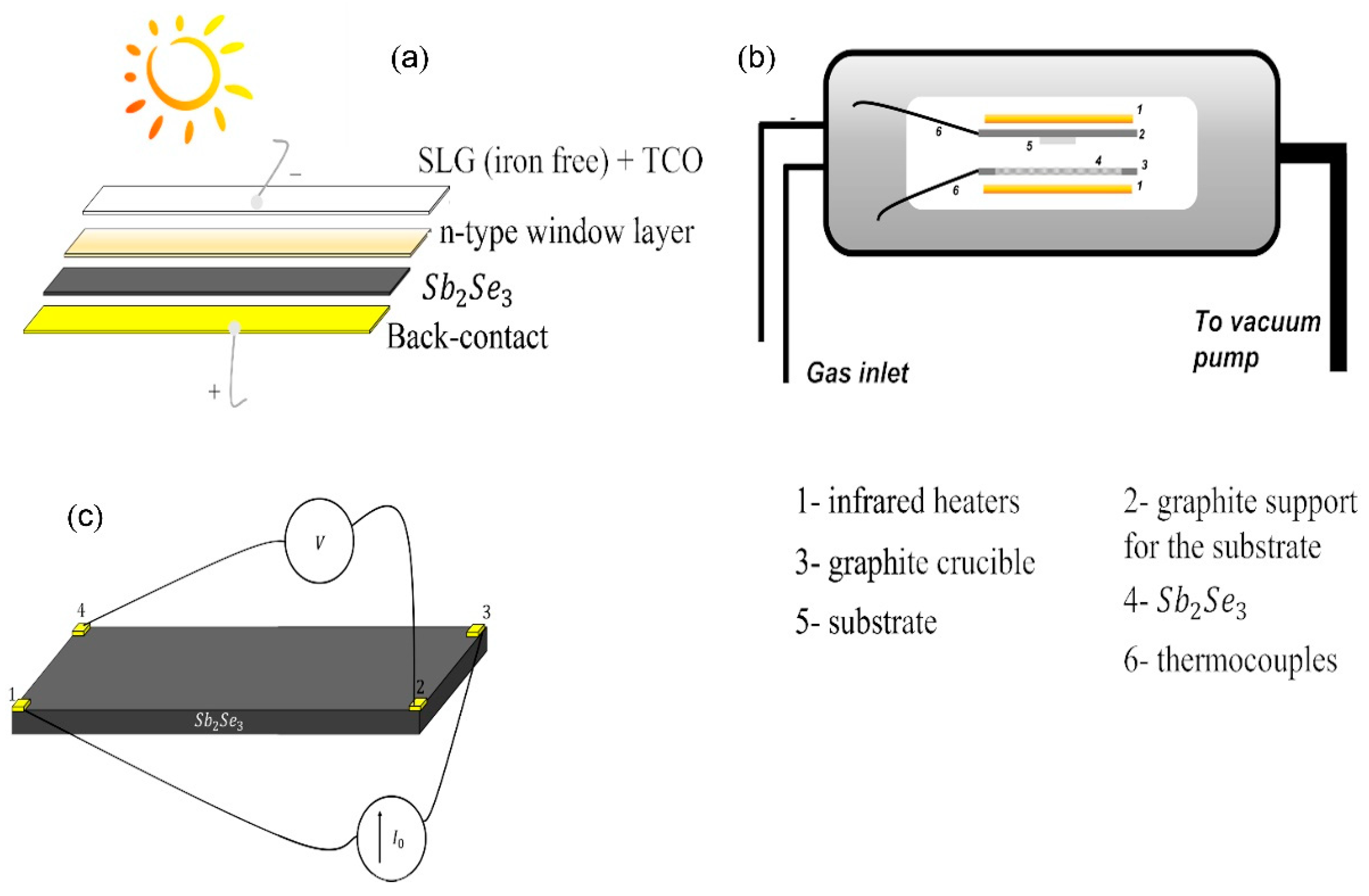
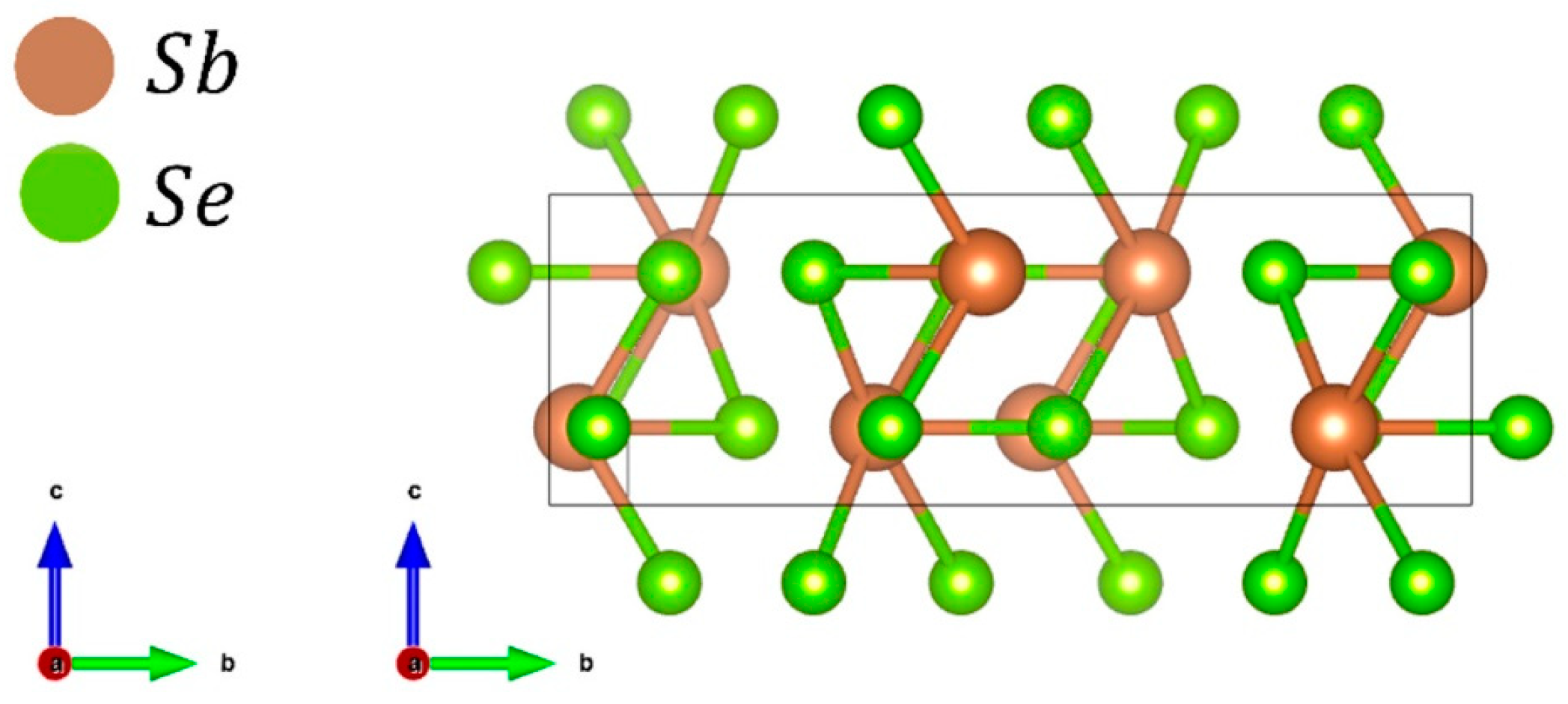
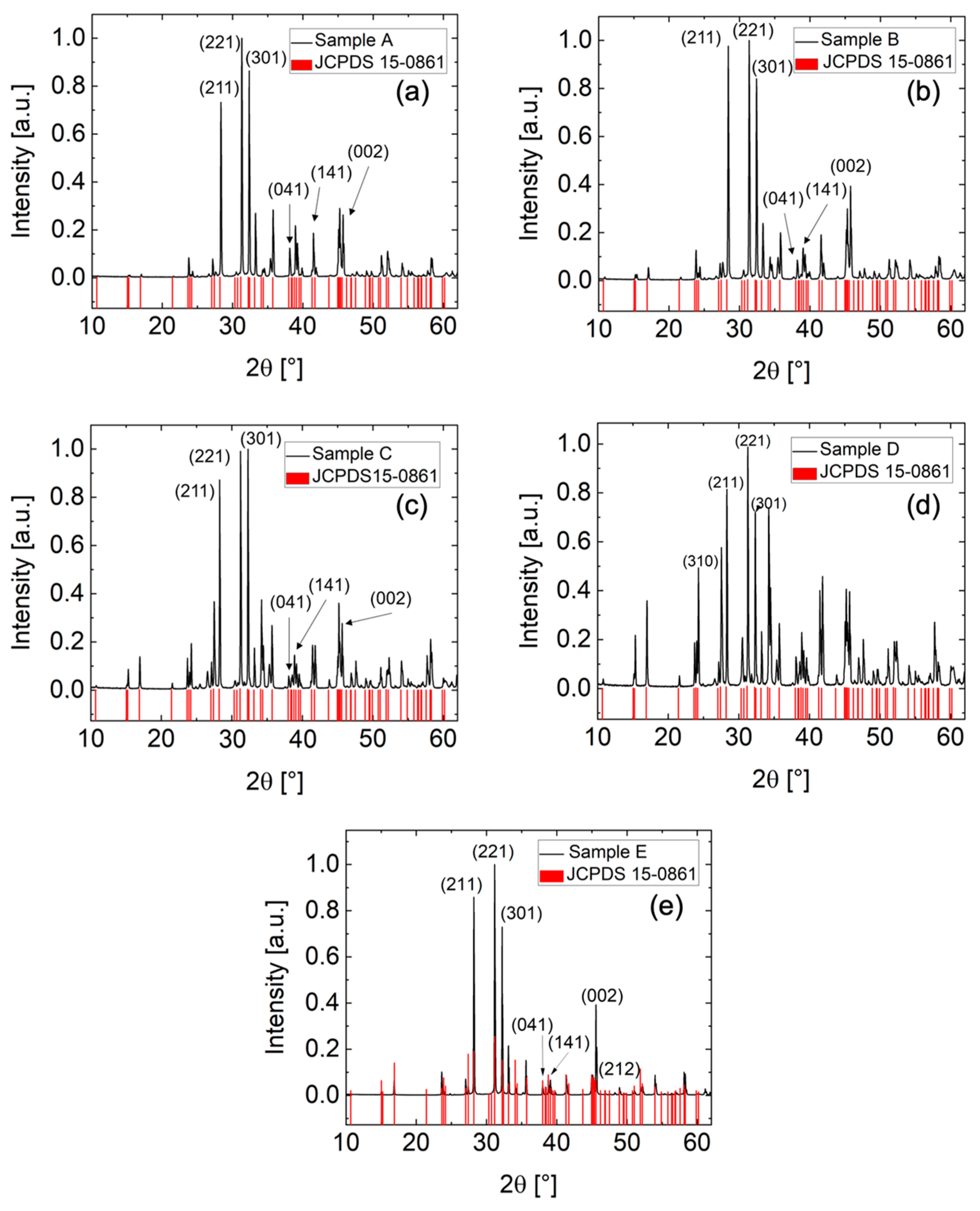

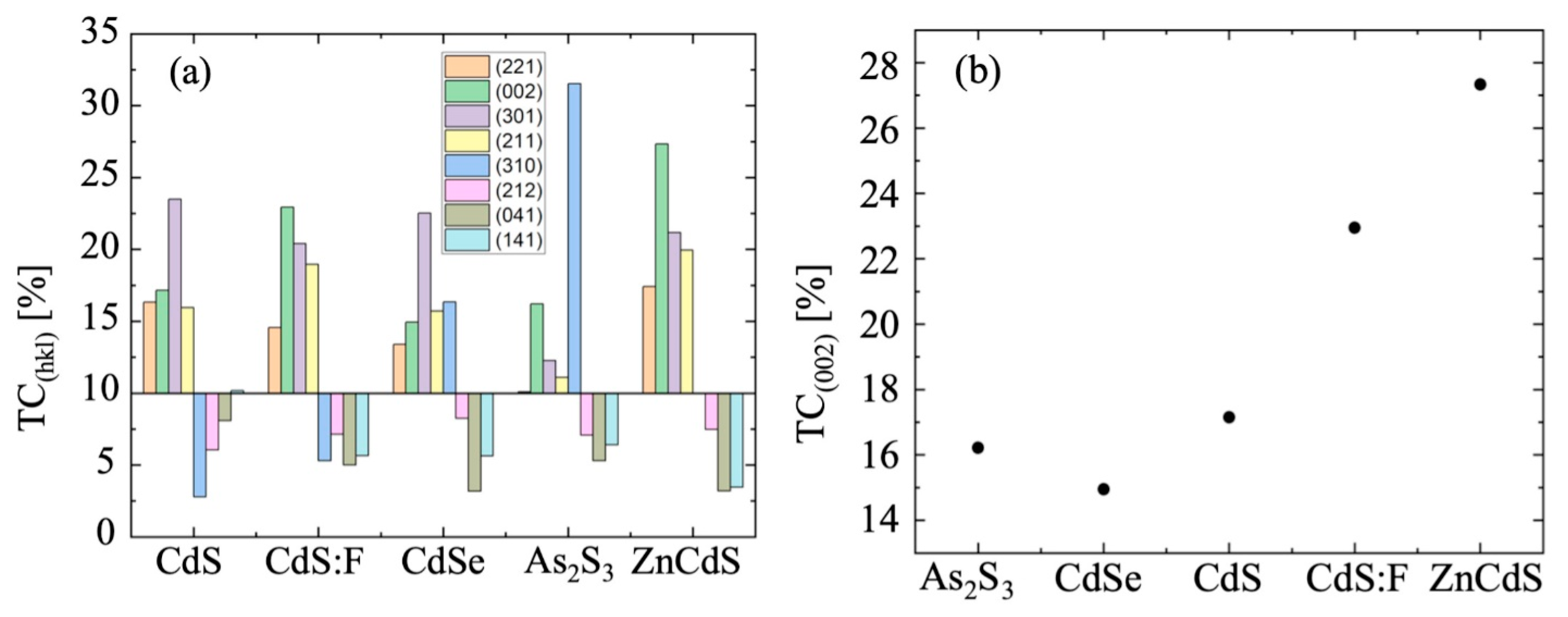
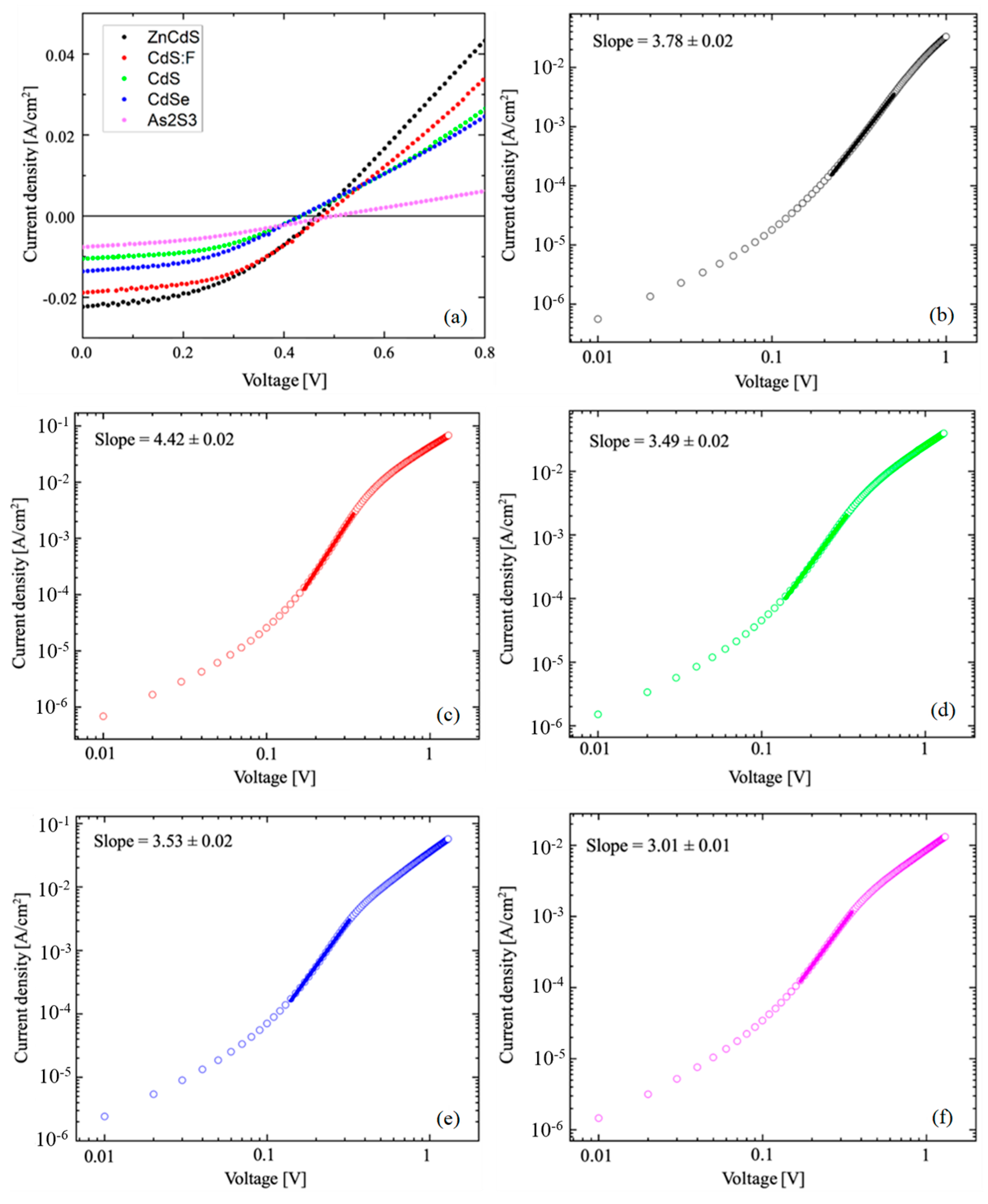
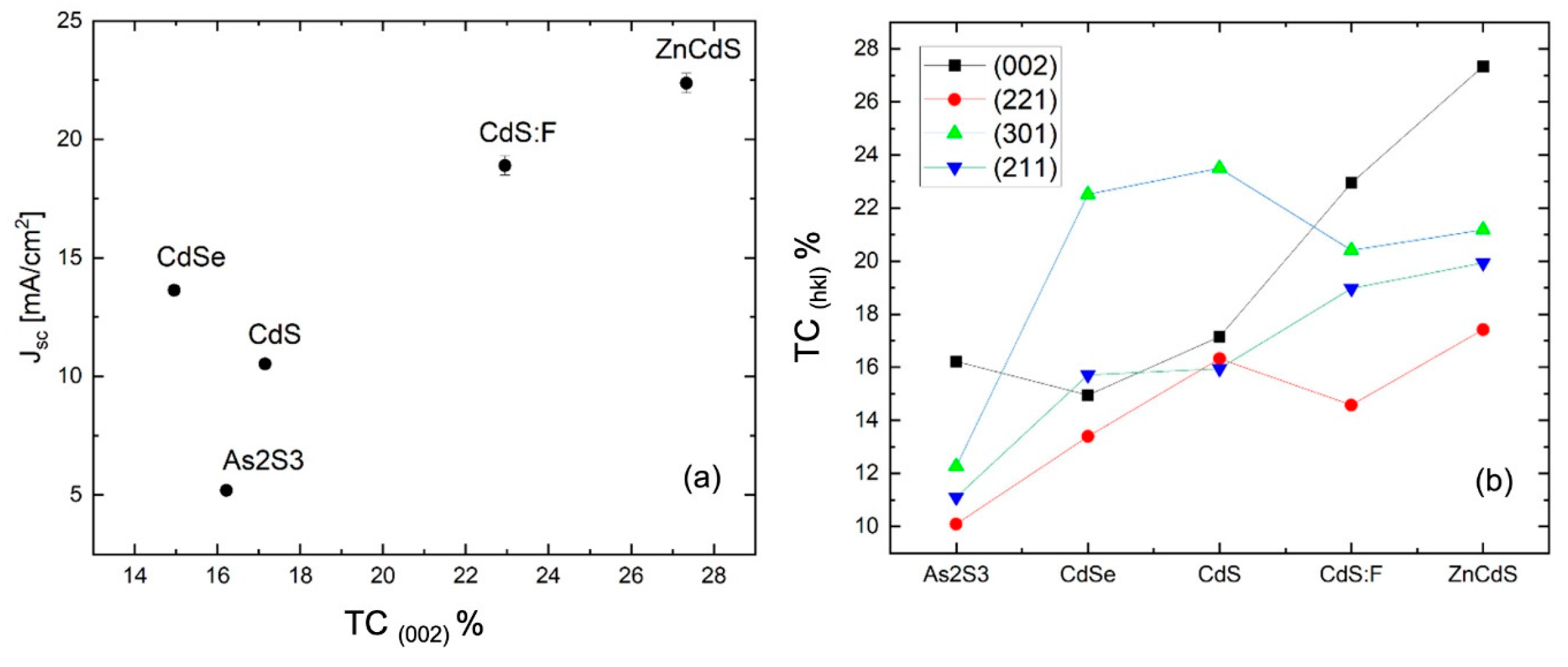
| Material (Working Atmosphere) | Substrate Temperature [°C] | Power Density [W/cm2] | Deposition Rate [Å/s] | Thickness [Å] | Sample |
|---|---|---|---|---|---|
| - | 250 | 0.7 | 4 | 3000 | A |
| CdS (Ar + CHF3) | 250 | 0.9 | 4 | 3000 | B |
| CdS + CdSe (Ar) | 250 | (0.7) (0.6) | (4) (4.4) | 3000 + 500 | C |
| CdS + As2S3 (Ar) | 220 | (0.7) (0.6) | (4) (2.4) | 3000 + 500 | D |
| CdS + ZnCdS (Ar) | 220 | (0.7) (0.8) | (4) (4) | 600 + 300 | E |
| - | Sample A | Sample B | Sample C | Sample D | Sample E |
|---|---|---|---|---|---|
| 139 | 107 | 98 | 124 | 86 | |
| 15 | 9 | 16 | 49 | 8 | |
| 10.5 | 18.9 | 13.6 | 5.2 | 22.4 | |
| 435 | 478 | 433 | 593 | 469 | |
| 0.45 | 0.46 | 0.43 | 0.34 | 0.43 | |
| 2.1% | 4.2% | 2.6% | 1.3% | 4.5% | |
| 3.0 × 1013 | 1.2 × 1013 | 2.3 × 1013 | 5.0 × 1013 | 3.6 × 1013 |
Disclaimer/Publisher’s Note: The statements, opinions and data contained in all publications are solely those of the individual author(s) and contributor(s) and not of MDPI and/or the editor(s). MDPI and/or the editor(s) disclaim responsibility for any injury to people or property resulting from any ideas, methods, instructions or products referred to in the content. |
© 2023 by the authors. Licensee MDPI, Basel, Switzerland. This article is an open access article distributed under the terms and conditions of the Creative Commons Attribution (CC BY) license (https://creativecommons.org/licenses/by/4.0/).
Share and Cite
Pasini, S.; Spoltore, D.; Parisini, A.; Foti, G.; Marchionna, S.; Vantaggio, S.; Fornari, R.; Bosio, A. Sb2Se3 Polycrystalline Thin Films Grown on Different Window Layers. Coatings 2023, 13, 338. https://doi.org/10.3390/coatings13020338
Pasini S, Spoltore D, Parisini A, Foti G, Marchionna S, Vantaggio S, Fornari R, Bosio A. Sb2Se3 Polycrystalline Thin Films Grown on Different Window Layers. Coatings. 2023; 13(2):338. https://doi.org/10.3390/coatings13020338
Chicago/Turabian StylePasini, Stefano, Donato Spoltore, Antonella Parisini, Gianluca Foti, Stefano Marchionna, Salvatore Vantaggio, Roberto Fornari, and Alessio Bosio. 2023. "Sb2Se3 Polycrystalline Thin Films Grown on Different Window Layers" Coatings 13, no. 2: 338. https://doi.org/10.3390/coatings13020338
APA StylePasini, S., Spoltore, D., Parisini, A., Foti, G., Marchionna, S., Vantaggio, S., Fornari, R., & Bosio, A. (2023). Sb2Se3 Polycrystalline Thin Films Grown on Different Window Layers. Coatings, 13(2), 338. https://doi.org/10.3390/coatings13020338





